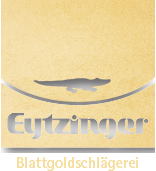Composition gold leaf and the problem of oxidation
Let’s get one thing straight right away: imitation gold and silver leaf as well as copper leaf oxidise, no matter how it is processed. You can slow down the oxidation process or even intensify it – whether intentionally or unintentionally – when working with them.
We have put together a few facts regarding the subject.
- Workshops/building sites – The humidity level of the workshop or the building site must be controlled. A humidity that is too high will speed up oxidation when using imitation gold and silver leaf and copper leaf. The ideal workshop or building site comes with air conditioning in summer and heating in winter.
- Substrates – The substrate that is being treated with metal leaf should be clean, free from grease, sealed, varnished, and outgassed. Tip: as long as the varnish is still outgassing and smells, it should not be gilded with imitation gold and silver leaf or with copper leaf. Freshly varnished surfaces constitute a high oxidation risk for these metals.
- Adhesives – Strictly speaking, there is no adhesive that is suitable for such metal leaf, as these always promote oxidation of the metal. The chosen adhesive must be applied thinly and allowed to dry fully before further work.
Processing and methods
Metal leaf should always be stored in a cool, dry place, and should always be kept well-sealed in a cardboard box or booklet. It should also never be touched with fingers, as fingerprints continue to oxidise even under a coat of varnish. You should therefore always wear cotton gloves when working with metal leaf. Caution: In summer, hands sweat and gloves can become moist. It may not be particularly comfortable, but the best solution is to wear latex gloves under your cotton gloves.
- Varnish coating – Imitation gold and silver leaf and copper leaf must immediately (always on the same day) be protected from oxidation with a varnish. Tests are always essential, as varnish manufacturers are constantly “optimising” their varnish formula. This varnish optimisation can often lead to unexpected problems with surfaces gilded with metal leaf. In the case of large surfaces, a second coat of varnish should always be applied. Accidentally missing a spot when varnishing quickly leads to oxidation and costly complaints.
- Brush/gun – When varnishing, always use clean brushes. It is essential that the varnish coats are thin. When using a paint gun, the first coat of paint should always be sprayed on thinly. Always use guns with compressed air systems with a refrigeration dryer. Moisture in a compressed air system promotes oxidation.
- Restoration – Even well-gilded and varnished metal leaf will slowly discolour over time. This makes restoration difficult, as a partial new gilding procedure must be tinted with great effort. Usually, a completely new gilding procedure is the fastest and therefore the most cost-effective solution.
The cost factor
The item to be gilded, the financial budget, and a long-term cost comparison are the criteria for deciding upon a material.
Gold leaf or composition gold? An easy calculation
In the case of oil gilding with gold leaf, material costs can be 2-3 times as high as labour costs. The labour costs incurred for oil gilding are comparable to the use of metal leaf. The additional costs of working with smaller genuine gold leaves are offset by the redundancy of varnish coating, which is necessary when working with a composition gold leaf surface.
Material costs for metal leaf/copper leaf compared to gold leaf – a ratio of approximately 1:40
A short example
€1,000 gold leaf + €2,000 labour costs = approx. €3,000.00
€25.00 composition gold leaf + € 2,000 labour costs = approx. € 2,025.00
Provisional result
The first gilding with composition gold leaf is always cheaper. But by the time of the first restoration of the metal leaf surface, it becomes expensive. The total costs for composition gold leaf gilding + first restoration can exceed a well-preserved gold leaf surface by up to 35%.
Example of total costs after the first restoration
€50 metal leaf + €4,000 labour costs = total cost of approx. €4,050.00
Information
The gold leaf surface (from 22 carat interior) does not need to be varnished. This saves both materials and a lot of time. The gold leaf will not oxidise and will retain its metallic surface with a natural reflectiveness and eternal shine.
Conclusion
Imitation gold leaf is a reasonably priced material for short-term surface metallisation, but, in the end, annoying oxidation will excel the joy caused by the lower initial cost.


